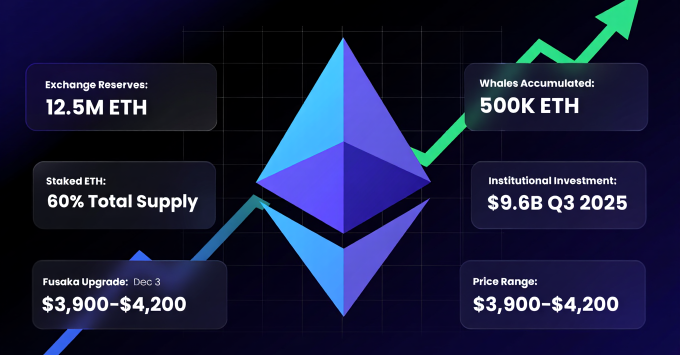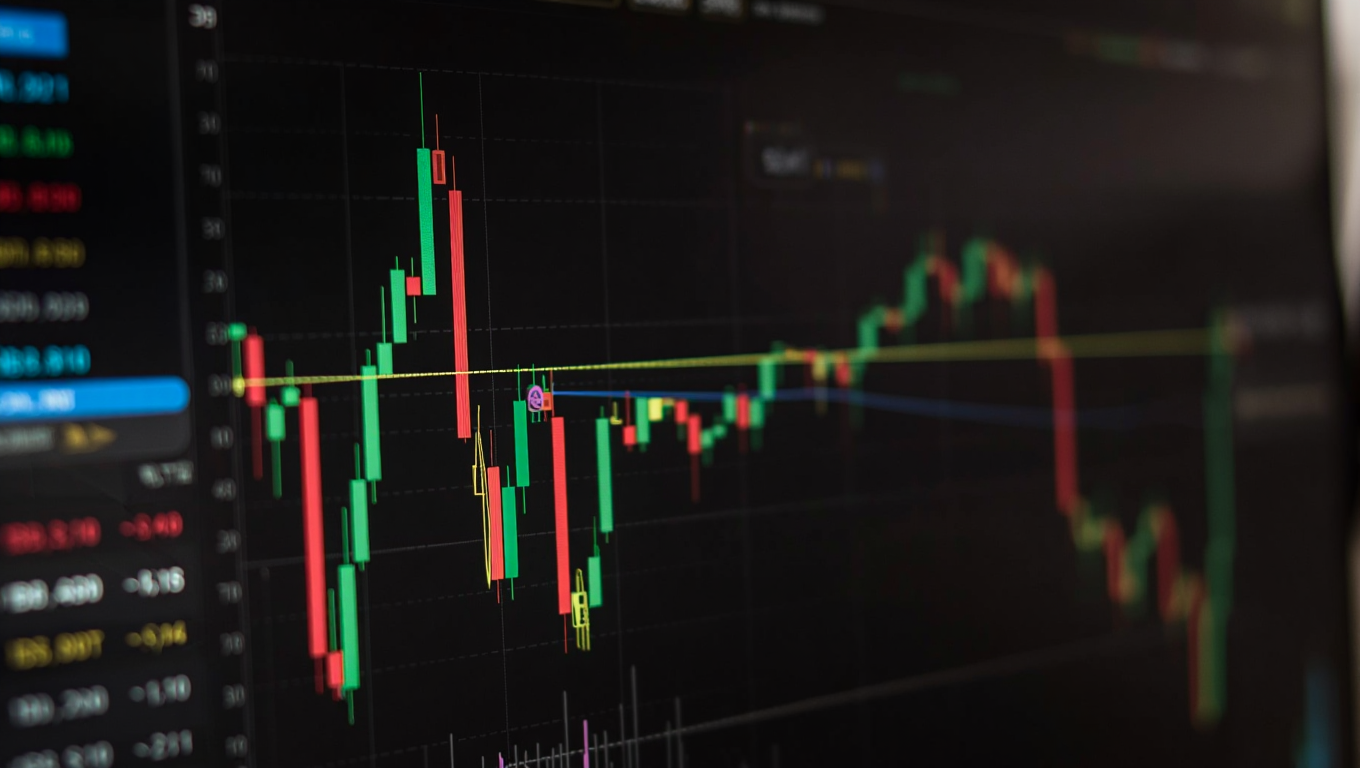Executive Summary
Ethereum is currently navigating a short-term consolidation phase, with prices fluctuating between approximately $3,900 and $4,200. Despite this price correction, the underlying structural trend remains firmly bullish. Furthermore, a confluence of powerful on-chain metrics, accelerating institutional capital inflow, and significant upcoming network upgrades substantiates this positive outlook.
Key bullish indicators include exchange reserves hitting an all-time low of 12.5 million ETH, signaling strong HODLing behavior, and a significant increase in staked ETH, which now accounts for 60% of the total supply. Concurrently, whale addresses have accumulated over 500,000 ETH in October. In addition, institutional investment in Ethereum products ($9.6B in Q3 2025) has surpassed that of Bitcoin. Meanwhile, the derivatives market, while showing reduced leverage, indicates a paradoxical bullish sentiment with negative funding rates. Moreover, the forthcoming Fusaka upgrade on December 3 is poised to dramatically enhance network scalability and efficiency, providing a strong medium-term catalyst. Although immediate price action ties to key technical levels, the confluence of fundamental strength suggests that the current price range presents an attractive entry point for a structurally sound asset.
1. Market Snapshot & Technical Analysis
Ethereum exhibits signs of short-term consolidation within a broader, long-term uptrend. Specifically, recent price action has seen a 3.48% decrease to $3,982, followed by movements to $4.13k and a subsequent 5.57% increase to $4.18k, accompanied by a significant 165.27% surge in trading volume.
1.1. Multi-Timeframe Technical Indicators
Overall, the analysis across different timeframes reveals a mixed short-term picture but confirms the long-term structural integrity of the uptrend.
| Timeframe | Trend | RSI | MACD | Key Level | Signal / Interpretation |
| 1-Hour | Weak Bearish | 32.9 | Bearish (-14.7 hist.) | $3,959 (Bollinger Lower) | Potential for an oversold bounce. |
| 4-Hour | Neutral | 42.2 | Bearish Cross (-23.8 hist.) | $4,083 (Bollinger Mid) | Range-bound activity; consolidation phase. |
| Daily | Consolidation | 46.8 | Bullish Divergence (+21.7) | $4,221 (SMA50) | Price holding above the Bollinger Mid-Band. |
| Weekly | Strong Bullish | 54.4 | Bearish (-55.7 hist.) | $4,080 (EMA12) | Price remains above long-term moving averages, confirming structural uptrend. |
1.2. Key Support & Resistance Levels
Liquidation data provides critical insight into key price levels where market pressure could shift.
- Strong Support: $3,844
- This level coincides with the 4-hour Bollinger Band lower boundary.
- Here, a significant $577 million in cumulative long liquidations cluster, forming a robust support zone.
- Intermediate Resistance: $4,083
- This represents the 4-hour Bollinger Band mid-line, a key pivot for short-term momentum.
- Strong Resistance: $4,100 – $4,117
- The options market’s “max pain” price of $4,100 reinforces this zone.
- Crucially, a $1.31 billion cumulative short liquidation risk exists at $4,117, creating an asymmetric risk profile that heavily favors the upside if the market breaches this level.
2. Derivatives Market Analysis
The derivatives market points to a cooling of speculative leverage while simultaneously flashing contrarian bullish signals.
- Open Interest: Stands at $47.65 billion, a 24-hour decrease of 3.61%, indicating a reduction in leveraged positions.
- Funding Rates: Major exchanges are showing negative funding rates (e.g., Binance -0.0054%, Bybit -0.0092%). Specifically, this signifies that short positions are paying long positions, a market condition that often acts as a contrarian indicator for a potential price bottom or squeeze.
- Liquidation Data: Over the last 24 hours, total liquidations reached 162 million. Long positions accounted for 73% (119 million) of this total, confirming recent downward pressure. However, the immense short liquidation cluster at $4,117 presents a more significant and asymmetric upward risk.
3. On-Chain Data & Network Health
On-chain metrics are exceptionally strong, painting a picture of a robust and growing network with high user conviction. In fact, Ethereum is experiencing peak on-chain activity, which DeFi usage, stablecoin transfers, and low gas fees are driving.
3.1. Network Activity & Usage
| Metric | Current Value | 7-Day Change | 30-Day Change | Assessment |
| Daily Transactions | ~1.05 Million | +2% | +5% | Stable and consistent growth. |
| Daily Active Addresses | 451,069 | -1.5% | +3% | Minor short-term dip within a long-term uptrend. |
| Gas Usage | ~105 Billion units | 0% | -8% | Decrease reflects L2 efficiency, reducing costs. |
3.2. Holder Analysis & Whale Activity
- Supply Concentration: The top 10 addresses now hold 61% of the total supply, an increase from 58% in September, indicating ongoing accumulation by large entities.
- Key Holders:
- Beacon Chain Contract: 66.1M ETH (54.7% of supply)
- Coinbase Custody: ~6.2M ETH (5.1% of supply)
- Grayscale ETF: ~3.1M ETH (2.6% of supply)
- Whale Accumulation: In October, top whale wallets accumulated over 500,000 ETH. For example, SharpLink Gaming purchased an additional 19,000 ETH on October 25.
3.3. Exchange & Staking Dynamics
- Exchange Reserves: The total ETH held on exchanges has fallen to an all-time low of 12.5 million ETH, a 15% decrease year-over-year. This is a powerful signal of long-term holding conviction and reduced sell-side pressure. Notably, Binance reserves alone fell by 17% in the last month to 3.87M ETH.
- Staking Growth: In parallel, investors have now staked a total of 71.83 million ETH, representing 60% of the entire circulating supply. This marks an 8% increase over the last month.
- Active Validators: 2.14 million
- Staking Yield (APR): ~3.5%
4. Fundamental Market Drivers
Ethereum’s fundamental case is strengthening through institutional adoption, regulatory clarity, and pivotal network upgrades.
4.1. Institutional Adoption & ETF Flows
- Institutional Dominance: In Q3 2025, institutional investors allocated $9.6 billion to Ethereum, surpassing the $8.7 billion invested in Bitcoin.
- ETF Activity:
- In terms of ETF Activity, BlackRock’s Ethereum ETF recently acquired 17,440 ETH, underscoring significant institutional interest.
- Although there was a recent single-day outflow of 93.6 million (linked to a BlackRock withdrawal), Ethereum spot ETFs still maintain a massive 14.35 billion in net inflows.
- For instance, a daily snapshot from October 27 showed a net inflow of $133.9 million, led by BlackRock’s ETHA.
4.2. Network Upgrades & Scalability
- Fusaka Upgrade (December 3): This upcoming hard fork is a major catalyst. It introduces Proto-Danksharding (P-rDAS), and analysts expect it to:
- Increase blob capacity by 8x (from 6 to 48).
- Raise the gas limit to 16.8 million.
- Dramatically improve L2 efficiency and reduce transaction costs.
- Layer-2 Innovation: Furthermore, the heavily oversubscribed ICO for MegaETH highlights the vibrant innovation occurring in the L2 space, which further enhances the network’s overall capabilities.
4.3. Regulatory Environment
- U.S. Regulatory Clarity: The SEC’s approval of the ERC-3643 standard for compliant tokenized assets is a major step forward, potentially unlocking a $1 trillion market. Additionally, the market views the appointment of a pro-crypto CFTC chair as a positive development.
- Global Adoption: On the global front, Japan’s first JPY-pegged stablecoin (from startup JYPC) launching on Ethereum demonstrates growing international acceptance and regulatory progress in digital finance.
5. Ecosystem & Sentiment Analysis
Market sentiment is currently neutral, but the underlying narrative within the community and among institutions is decidedly long-term bullish.
- Market Sentiment: The Fear & Greed Index is at 51, indicating a “Neutral” stance.
- Community Outlook: Prominent opinion leaders are maintaining long-term price targets of $10,000, with a narrative spreading that focuses on the upcoming upgrades and accelerating institutional demand. Consequently, there is a growing consensus that the market undervalues Ethereum.
- DeFi Growth: The ecosystem is maturing, evidenced by a surge in DeFi Total Value Locked (TVL) to $89 billion. This growth, combined with high demand for stablecoin transactions, is contributing to the narrative of an emerging “supersycle.”
- MetaMask Enhancements: Finally, improvements to MetaMask’s asset transfer speeds and multi-chain account functionality are bolstering interoperability and DeFi adoption.
6. Trading Scenarios & Risk Management
Based on the technical structure, two primary scenarios present themselves.
| Scenario | Entry Price | Target Price | Stop-Loss | Risk/Reward Ratio | Assessment Probability |
| Bullish Reversal | $3,980 | $4,100 | $3,950 | 4.00 | High |
| Bearish Continuation | $3,980 | $3,844 | $4,020 | 3.40 | Medium |
Recommended Risk Management:
- Position size should not risk more than 0.75% of total portfolio equity.
- Traders should keep leverage below 5x.
- Also, monitor market dynamics around the upcoming options expiry on October 31.
Conclusion
Ethereum is exhibiting classic signs of a healthy consolidation within a powerful, long-term secular uptrend. Therefore, while short-term price action remains choppy, the fundamental and on-chain data presents an overwhelmingly bullish case. The historic low for exchange reserves, coupled with 60% of the supply being staked and aggressive accumulation by whales, demonstrates profound supply-side conviction. At the same time, surging institutional demand and the major technological catalyst of the Fusaka upgrade match this conviction. The structural uptrend remains valid as long as the price holds above the $3,700 level. Consequently, traders should view any dips towards the strong support cluster at $3,844 as strategic buying opportunities.
Important Notice : The information presented is not a recommendation to invest. All investment decisions and any resulting outcomes are the sole responsibility of the individual.
AD



